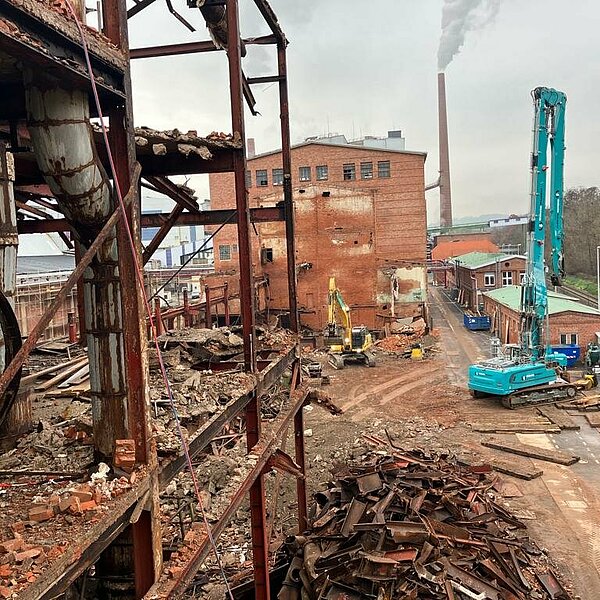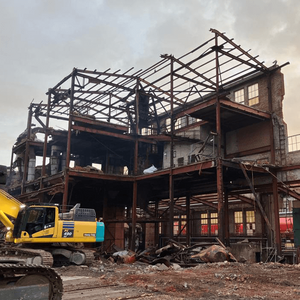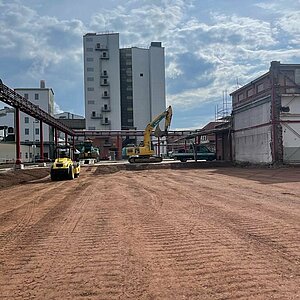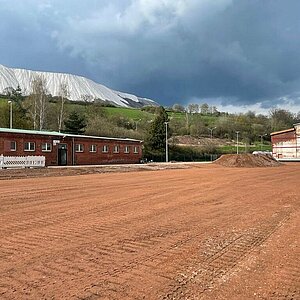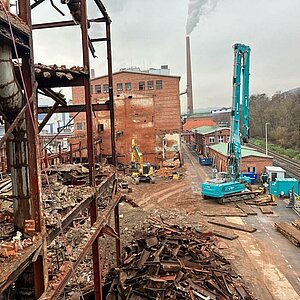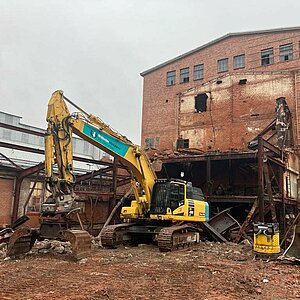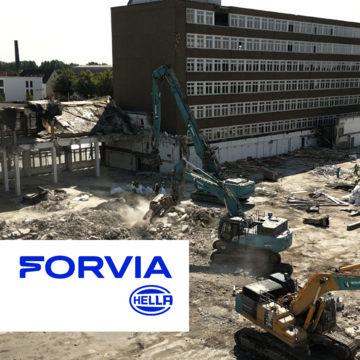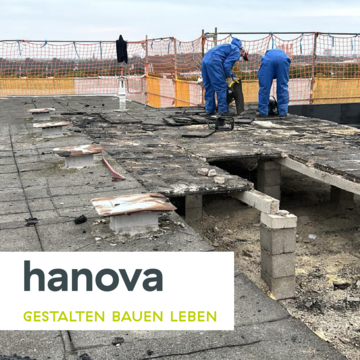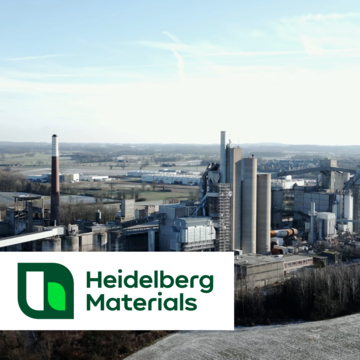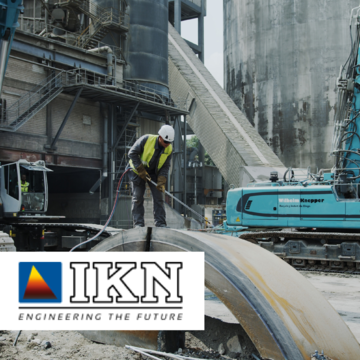Work carried out
- Complete conception and planning of the measure
- Dismantling of production building with directly adjacent plant components in operation
- Recycling of carrier scrap contaminated with heavy metals
- Separation and on-site recycling of the analytically safe construction waste
- Construction of a load-bearing gravel subgrade after completion of the demolition work
Machines in use
- Demolition long front excavator 33 m
- Various demolition chain excavators up to 60 tons operating weight
- Mobile crushing and screening technology
- Various earthmoving equipment with 3D machine control
- Various mobile cranes and working platforms
The project in detail
1000 tons of steel - sounds like a lot, but for the demolition and recycling specialist Knepper this is not a significant amount. The challenge in demolishing the former magnesium factory on the K+S site in Wintershall was, on the one hand, the special structural conditions and, on the other, the fact that plant operations continued as normal during the demolition. This required a well thought-out concept. Knepper submitted the best plan in the tender among the largest and best-known demolition companies in the industrial dismantling sector and was awarded the contract.
The former magnesium factory at the K+S Wintershall site had been empty since the 1980s. The industrial building, built around 1933 as a steel skeleton structure with a brick and reinforced concrete façade, had been used for various purposes over the years, most recently for potash salt processing. The potash salt had accelerated the corrosion of the steel and the progressive decay was becoming more and more of a safety risk for K+S. It was no longer economically viable to renovate the building in accordance with the current state of the art and fire protection standards. The old industrial building therefore had to make room for future developments. In future, the 4000 square meter site will be used for planning offices, a container village and as a storage and staging area in order to drive forward the far-reaching "Werra 2060" project. One of the aims of the project is to further improve the ecological footprint of domestic potash production.
Knepper impresses with demolition and disposal concept
"Knepper convinced us with its well thought-out overall concept, which is the result of a great deal of experience in industrial demolition," says Daniel Otto, construction operations engineer at K+S at the Wintershall site, explaining the decision in favor of the demolition specialist Knepper.
"The building was located in the middle of the plant site and the electrical buildings, which provide the power supply for the entire plant, were directly adjacent to the north and south sides. On the west side, the laboratory building is only separated by a narrow road and on the east side there are tracks. Neither the production of the plant was to be hindered nor the adjacent buildings damaged during the demolition." otto sums up and concludes:
"The high safety requirements and the cramped spatial conditions made the demolition a logistical masterpiece."
Construction phases 1-3
Construction phase 1
Knepper's solution was a mixture of manual locksmith technology and mechanical demolition, which required structural expertise during the planning phase. After the electricity, steam and pneumatic pipelines for transporting the product samples to the laboratory, which were still connected to the old building, had been re-routed, Knepper first began with the manual dismantling of the gable ends. The dismantled parts were lowered by crane. In order to optimally protect the adjacent existing buildings during mechanical demolition, a demolition aisle of 3 meters was created on the south and north sides between the building walls. The interior of the building was then gutted. Demolition curtains were placed on the west and east sides as a protective measure.
Construction phase 2
In the second construction phase, Knepper's 93-tonne longfront excavator arrived to demolish the steel frame with its 33-metre boom and special tools. Another crawler excavator with a 6-ton shear took over the cutting of the steel girders. There were also plant components weighing several tons, such as tank containers, on the platforms. Unknown weights of old systems also required flexible adjustments to the dismantling concept and the use of mobile cranes at short notice; adherence to the schedule had the highest priority in addition to maximum occupational safety. The demolition material had to be cleared away in the shortest possible time in order to keep the escape routes on the factory premises clear.
Construction phase 3
The third construction phase involved processing the demolition material, disposing of it and recycling it in accordance with waste disposal regulations. For this purpose, the material was crushed on site to a specific grain size and temporarily stored on a surface. The former cellars were backfilled and consolidated with the uncontaminated concrete and brick material to leave a load-bearing and level surface. The earthworks were carried out by Knepper's specialized earthworks department. The approximately 1000 tons of scrap steel could not be returned to the raw material cycle without further ado, as they were painted with a lead-containing anti-corrosion paint. The contamination required special disposal methods and treatment processes. Here too, Knepper was able to draw on a broad network and many years of experience.
Ahead of schedule
Despite the special challenges, the project was handed over to the customer for further use one month before the planned completion date. Smooth processes thanks to a well-coordinated team and Knepper's wide range of services were crucial to this. The innovative disposal methods offer an additional advantage for the customer, as the proceeds from recycling, in this case steel scrap, play a significant role in the costing of such a project.
Your contact person
SALES DEMOLITION AND DISMANTLING
Phone: +49 2941 2841-310
E-Mail: vertrieb@knepper-gruppe.de
Quotes
“Knepper convinced us with its well thought-out overall concept, which is the result of extensive experience in industrial demolition.”
Daniel Otto
Construction operations engineer at K+S at the Wintershall site
